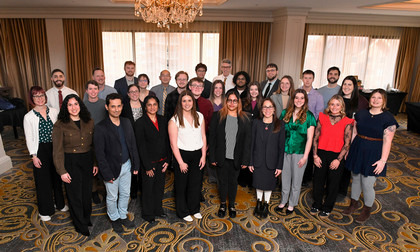Ayushee Dasgupta (Biology/Chemistry, Kolkata, India) won 2nd place for her oral presentation “Exploring the gut microbiota of gray bats in Kansas following culturable and metagenomic approaches.”
Dasgupta’s research has been done in collaboration with former graduate student Bobbi Monroe, Associate Professor Andrew George, and Associate Professor Anuradha Ghosh (Biology).
Bats help control insect populations but can also carry disease causing microbes. Learning more about bat gut bacteria can help with disease prevention and conservation.
This study looked at the bacteria found in gray bats in Southeast Kansas by analyzing their droppings. The researchers found 32 types of bacterial genera that were metabolically diverse as revealed by performing several biochemical tests. Based on sequencing data, the most common types being Serratia, Achromobacter, Lysinibacillus, and Bacillus. Multi-drug resistance was also reported in these bacterial isolates along with the ability to form biofilm which allows them to grow and persist on both living and non-living surfaces.
The researchers also studied differences between male and female bats using metagenomic approach, finding male and female gray bats contained the same bacterial genera while females had a higher concentration of microbes.
Dasgupta is going to pursue a PhD program in molecular biosciences at the University of Kansas to further contribute to the field of biomedical research.
Clarissa Wedman (Biology, Overland Park) was honored with an award for her poster “Carbon sequestration across ecological and urban gradients in Kansas.”
Wedman’s research has been done with Associate Professor Christine C. Brodsky (Biology).
Carbon sequestration is the process of capturing and storing carbon dioxide in plants, helping reduce greenhouse gases. Trees do more than just store carbon — they also clean the air and water, cool temperatures, prevent pollution and erosion, and provide habitats for wildlife, especially in cities.
This study looked at how carbon sequestration varies across forests, grasslands, and urban areas in Kansas. The researchers focused on 17 cities along the I-70 corridor, each with at least 1,000 people. Using the i-Tree tool, they gathered data on tree species, carbon storage, tree size, and land development.
Results showed that elms and hackberries were the most common city trees. Larger trees stored more carbon, and cities with bigger populations also had greater carbon sequestration rates, most likely due to the largest surveyed cities occurring in the eastern, forested part of the state. However, the level of urban development (from low to high intensity) surprisingly did not significantly affect carbon storage. The findings suggest that tree growth and carbon storage are influenced by a natural shift from forests to grasslands across Kansas and urban residents’ preferences for trees in their landscapes.

Pitt State was represented at the symposium by 19 total students and nine faculty from the departments of Biology, Chemistry, Psychology & Counseling, and Health, Human Performance, and Recreation. Also attending were Dean of the College of Arts and Sciences Chris Childers and Provost Susan Bon.
Other participating institutions were the University of Kansas Medical Center, Emporia State University, Fort Hays State University, Haskell Indian Nations University, Kansas State University, University of Kansas, Washburn University, Wichita State University, and Langston University.